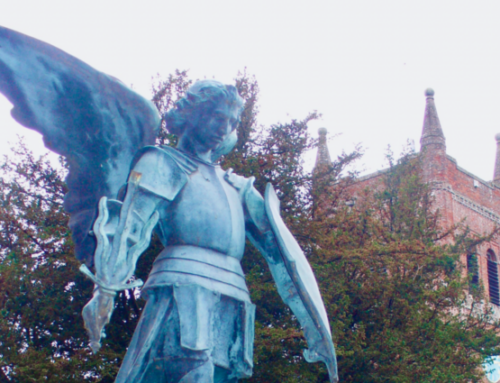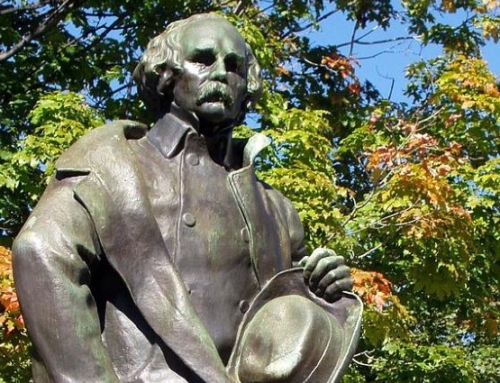Sister Claire’s meditations, chock full of great quotations from great thinkers and pray-ers of the past, as well as liturgical prayers and hymns, combined with her well-organized set of passages taken from the whole of the Bible, make this thin volume extremely useful not only for private study but for preparation for teaching and preaching on the prayer that Jesus taught us.
Our Father: A Biblical Meditation on the Lord’s Prayer by Sr. Claire Waddelove, OSB (188 pages, Gracewing, 2020)
 The theologian Lawrence Cunningham once observed, “Rosary beads count prayers that may or may not count.” It’s a funny but challenging line for Christians who are susceptible to praying with lips but not the heart. Some Protestants think the problem (apart from asking Mary to pray for us) is rote prayers themselves. If one prays extemporaneously, the reasoning goes, then one prays sincerely. Problem solved!
The theologian Lawrence Cunningham once observed, “Rosary beads count prayers that may or may not count.” It’s a funny but challenging line for Christians who are susceptible to praying with lips but not the heart. Some Protestants think the problem (apart from asking Mary to pray for us) is rote prayers themselves. If one prays extemporaneously, the reasoning goes, then one prays sincerely. Problem solved!
Alas, extemporaneous prayer is also subject to what the theologians ought to call spiritually “phoning it in.” Extemporaneous prayer is as easy to do as reciting rote prayers. For, as anyone who’s actually listened to extemporaneous prayer knows, most people who pray extemporaneously simply create a patchwork of biblical and pious phrases strung together with some connecting words. For those with any facility with words and a bit of biblical knowledge, it’s pretty easy to create the impression of spiritual depth even as one’s mind is paddling through the shallows or even off scheduling the weekend. (As in the life of prayer, so in life in general—“I love you” must be one of the most rote and most spontaneous declarations of human relations.)
For many, these extemporaneous prayers resemble Republican political speeches, which famously tend toward the reading of stage directions rather than the lines themselves. The political speechifiers tell us what they want to convey rather than conveying it. The prayer speechifiers tell the Lord, “I come before you, Lord, and just wanna ask that you would fill this room with your Spirit this evening.”
You wanna, do ya? Why dontcha go ahead and do it?
Don’t get me wrong. Extemporaneous prayers are not suspect or unseemly either in public or in private. In private, as John Henry Newman said, there are times when prayer comes to us and forms are unnecessary. Our troubles or gratitude pour out of us like floods of living water. But most people, even saints, have long stretches where their souls are not flooded, but arid and dry. We need to borrow the words in order to mean and feel what they convey..
So, too, in public. Sometimes an extemporaneous prayer is “just” successful because it is simple and heartfelt and reflects the pray-er’s own state of soul. But not everyone charged with public prayer can be counted on to be in such a state at the right time. And temptation lurks for those who are speaking to God on behalf of the people. Seeming to be a messenger intimate with God can usurp the job of humbly delivering the message. Few people actually can extemporaneously deliver something that’s good, powerful, and meaningful without doing a bit of verbal showing off.
Besides which, prayers that have been hallowed over the centuries have a unique power. In her book Facing East, Frederica Mathewes-Green recounts an Orthodox priest friend who was asked to pray at a pro-life rally in the South, where the vast majority of the people were Evangelicals or charismatic Christians. He prayed the traditional trisagion prayers, but instead of chanting them, he delivered them in plain speech, pausing for emphasis on each phrase.
“Holy God, . . .holy mighty one, . . .holy immortal one. . . . Have mercy on us!”
At the end of the rally, the bearded and robed cleric was besieged by Baptists and Pentecostals telling him he sure knew how to write a prayer.
The key was, of course, that he hadn’t written that prayer. He had been taught to pray it among many other prayers. The most famous and most ecumenical one, of course, is the prayer known as the Lord’s Prayer to Protestants and the Our Father to Catholics (Orthodox tend to use either term). In English, apart from the questions about whether to ask the Lord to forgive our “debts” or our “trespasses” and whether to pray the non-but-not-unbiblical doxology (“For thine is the kingdom. . .”) at the end, it is a prayer that unites all Christians. Even advocates of extemporaneous prayer will allow for this one since it was taught by Jesus himself.
 But how do you learn to really pray this prayer rather than merely “saying” the prayer? How do you make the Our Father count instead of merely counting Our Fathers? The best way, I think, is to study the parts of this dense prayer and see how they sum up the entire Christian faith in order that when praying it, the words you are saying will summon up so many other of God’s words. There are a number of good resources to do this. Of modern ones, I have benefited from the final section of the Catechism of the Catholic Church, several of Ronald Knox’s sermons on this prayer, and the treatment by Joseph Ratzinger (Pope Benedict XVI) in his marvelous Jesus of Nazareth trilogy.
But how do you learn to really pray this prayer rather than merely “saying” the prayer? How do you make the Our Father count instead of merely counting Our Fathers? The best way, I think, is to study the parts of this dense prayer and see how they sum up the entire Christian faith in order that when praying it, the words you are saying will summon up so many other of God’s words. There are a number of good resources to do this. Of modern ones, I have benefited from the final section of the Catechism of the Catholic Church, several of Ronald Knox’s sermons on this prayer, and the treatment by Joseph Ratzinger (Pope Benedict XVI) in his marvelous Jesus of Nazareth trilogy.
Sister Clare Waddelove, OSB, a Benedictine nun at St. Cecilia’s Abbey on the Isle of Wight, has produced yet another good resource in her 2020 book, Our Father: A Biblical Meditation on the Lord’s Prayer. I did not see any reference to Knox in her treatment, but she takes insights from the Catechism, the Fathers of the Church, the great medieval doctors, and modern figures such as St. John Henry Newman and Joseph Ratzinger. Indeed, her introduction cites the latter’s understanding from his trilogy of the Our Father as no “mere provision of a prayer text,” but instead a set of “signposts to interior prayer” that “provide a basic direction for our being” and “aim to configure us to the image of the son.” The prayer does so by aiming to “train us in the inner attitude of Jesus.”
Such lofty language might make the book sound hopelessly deep or intellectual, but this is not the case. In her brief preface, Sister Claire notes that this is not a scholarly tome. Instead, it is “offered to a general readership with the hope of encouraging that immersion in the sacred Scriptures and meditative prayer which brings closeness to God in a unified life.” Though the aim is indeed contemplation of God, this is not opposed to action. Sister Claire wants to help people adopt Jesus’ inner attitude not merely to raise consciousness, as we like to say today. Instead, she wants to help the Christian respond to conscience, that “aboriginal vicar of Christ,” as Newman called it.
Our Father stresses throughout the practical spiritual implications of the prayer. In the very first chapter, the explanation of the use of “our” with reference to God’s fatherhood is that “we are not isolated individuals but members of one family.” What that means, however, is that the way in which we both “regard” and “treat” others must be different from the kind of family relations we see in Cain’s unbrotherly love. Sister Claire immediately quotes the stirring promises and rewards of the Johannine epistles concerning treatment of brothers, as well as the Sermon on the Mount’s deepening of our understanding of what the commandment not to murder means: anger and insult are included, as well as indifference.
This summary of one short page in the book may be said to represent the whole book’s method. Each chapter is focused on a single clause of the prayer. It begins with Sister Claire’s own meditation, usually about five to seven pages long. Sister Claire’s prose has the kind of plainspoken tone that draws attention not to itself but to its subject, which she treats directly. I suppose the lack of rhetorical pizzazz might put some off. But what might be lacking in verbal fireworks is more than made up for by not shying away from the fire.
Sister Claire does not try to smooth away tough teachings, such as those warnings about not forgiving leading to not receiving forgiveness or the demand that our faith issue in works of charity. “Our charity or lack of it will determine our eternal destiny,” she writes. For Protestant readers who might read into this the specter of Pelagianism, however, it is important to note that the practice of charity is no DIY salvation program: “Battling alone, through pride and self-righteousness, we won’t endure. Throwing ourselves on God’s mercy and imploring his aid, distrusting ourselves, but trusting in him, we can stand firm.”
What follows her meditations are a “biblical meditation” on the prayer, which is simply an organized set of passages from the Old and New Testament that illumine the clauses of the Our Father. So, for instance, the clause about forgiveness includes passages on God’s forgiveness and his call to repentance in both Testaments, warnings about those who do not repent, biblical examples of confessions of sins, Christ’ delegation of the authority to forgive sins to his Apostles, biblical examples of mercy and forgiveness, and more.
A final bonus chapter on Mary illuminates how this woman, the first of all to believe in her son, represents and models faith, hope, and that charity that determines whether we’ll hang on to the faith or hope. It also illuminates her role, acknowledged by Catholic, Orthodox, and many Anglican Christians, as one who still aids the disciples of Jesus with her own prayers as a mother.
Sister Claire’s meditations, chock full of great quotations from great thinkers and pray-ers of the past, as well as liturgical prayers and hymns, combined with her well-organized set of passages taken from the whole of the Bible, make this thin volume extremely useful not only for private study but for preparation for teaching and preaching on the prayer that Jesus taught us. The Our Father gives us the proper content for prayer and the proper stance of the pray-er, whether it inspires us to additional traditional prayers or to extemporaneous prayers to our Heavenly Father.
This essay was first published here in September 2022.
The Imaginative Conservative applies the principle of appreciation to the discussion of culture and politics—we approach dialogue with magnanimity rather than with mere civility. Will you help us remain a refreshing oasis in the increasingly contentious arena of modern discourse? Please consider donating now.
The featured image is “The Lord’s Prayer” (between 1886 and 1894), by James Tissotin, and is in the public domain, courtesy of Wikimedia Commons.







Thank you for this.
I will take a further look.
Do you know what it costs?
Imaginative Conservative reviews always have the title of the book hyperlinked to the publisher or a seller such as Amazon or Barnes and Noble. Sister Claire’s book goes for $17.75 on Amazon.
That is a… fine piece of writing, sir. And I will definitely be looking for that book.
Are there anymore powerful words than “ ‘Our’ Father “ …spoken by our Lord and Savior Christ Jesus ? He himself brings us into the very presence of God , unlike anyone who came before Him. What is it that he has done like no other? Cleanses us, washes us, makes us holy, by his cross of death and resurrection, for our forgiveness of sins.
You write, “What follows her meditations are a ‘biblical meditation’ on the prayer,
which is simply an organized set of passages from the Old and New
Testament that illumine the clauses of the Our Father.”
I noticed one clause that was not mentioned in your essay, nor illumined by Ms Waddelove , and it has always seemed more important than its scant mention in exegeses. That is simply the two words “on earth”, in reference to the establishment of God’s kingdom.
I often ask at that point in a discussion, ‘How much crime is there in heaven? How much sadness? How much war? Famine? Death?’
The usual – and correct – answers are of course ‘None of the above.’
‘So then’ I ask ‘would you like to see and live on an earth run by that sort of government?’
Thee are only two rational answers there. One ends the conversation, the other opens it up.
What about you, Mr Deavel? Would you like to see and live on an earth run by that sort of government?